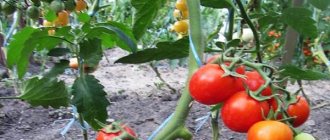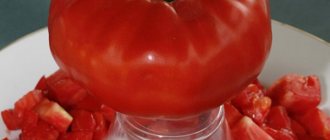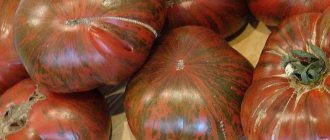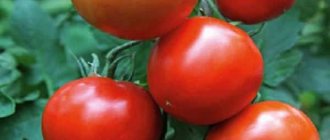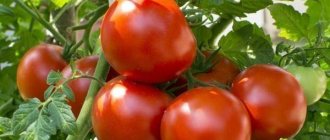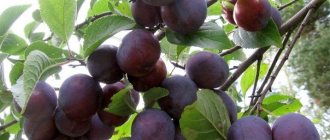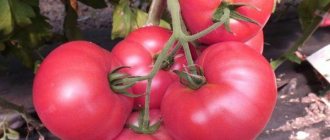Brief information about the variety
- Fruits and bush : tomatoes are raspberry-pink in color, heart-shaped, cuboid-shaped, weighing from 200 to 500 g; indeterminate bush, height from 150 to 250 cm.
- Productivity : above average (5-6 kg per bush).
- Disease resistance : average, requires prevention.
- Distribution : in the south it can be grown in open ground, in the middle zone - in greenhouses.
- Application : salads, slicing, main courses, processing.
- Planting : seedling method, sowing - in early or mid-March, transplanting into a greenhouse - in the first ten days of May; planting pattern – 50×50 cm.
- Soil : light, neutral.
- Care : watering - once a week, fertilizing - 5-6 times per season, formation - 1-2 stems, tying to a support - mandatory.
- Ripening period : medium-late – tomatoes ripen 115-130 days after emergence. In a cool room, the fruits can be stored for a month.
Varietal features
In the list of the most popular varieties, a description of the Kiev tomato is often found, since they have unique characteristics in comparison with other representatives of the crop:
- The bush is classified as an indeterminate plant (that is, one that does not stop growing).
- On average, the height of the bush is 1.7-1.8 m, but as reviews from vegetable growers show, for some the bush grew to 2.5 m.
- The leaves are ordinary, medium-large in size, dark emerald in color.
- The stalk has no spots.
- Tomatoes of this variety have an ordinary type of inflorescence.
- As the description of the Kiev tomato shows, the fruits are large in size and have an average weight of 300-500 grams. If you follow the basic rules for growing a tomato, you can grow a fruit weighing 1000 grams.
- “Kievlyanka” is rich in vitamins, antioxidants and minerals. Therefore, eating them will help prevent the development of diseases of the cardiovascular system; in addition, tomatoes are rich in vitamin A and organic acids, which has a beneficial effect on vision.
- Unripe tomatoes are light green in color; as soon as ripening begins, in greenhouse conditions they turn pink, with some orange splashes. If the plant is grown in an open space with a normal amount of light and a warm climate, then tomatoes of this variety acquire a crimson color.
- This variety has high yields.
Tomatoes are suitable for home-cooking; housewives prefer to make juice from Kiev tomatoes. If you choose exclusively ripe fruits, it will have a honey flavor. During processing, you can notice that there are small voids inside the fruit, this is explained by the characteristics of this type of tomato, but this fact does not affect other parameters of the fruit.
Characteristics of the variety
The ripening period of Kievlyanka tomatoes is medium-late (115-130 days after the formation of shoots).
Description of the bush
The bush belongs to the indeterminate type and grows up to 150-250 cm. The foliage of the tomato is average. The fruits are set in 4-6 pieces in a cluster.
Description of fruits
Tomatoes have a beautiful raspberry-pink color and large size - from 200 to 500 g (individual fruits can reach much greater weight - up to 1 kg). The shape of Kievlanka tomatoes is heart-shaped and cuboidal. The pulp is fleshy, with small voids. The taste is rich and sweet.
Area of application of fruits
The fruits are good in slices and summer salads. According to the description of the Kievlyanka variety, they are not suitable for canning and pickling. Tomatoes can be used for preparing second courses (stew or bake), as well as for processing (juices, ketchups, pastes).
Productivity
Yield characteristics are above average. 5-6 kg of fruits are collected from one bush. To increase these indicators, tomatoes are grown in a greenhouse, a bush of 1-2 stems is formed, and fertilizing is done regularly.
Resistance to diseases and pests
Tomatoes of the Kievlyanka variety do not get sick often, but require mandatory prevention (crop rotation, humidity control, bush formation, loosening the soil, weeding).
Due to the large and sweet fruits, the variety can be affected by pests:
- whitefly;
- aphids;
- spider mite.
The susceptibility of a variety to pests does not depend on the size and taste of the fruit, because insect pests do not feed on fruits, but on the vegetative parts of the plant - leaves, shoots.
To prevent whitefly attacks, you can hang sticky tapes; At the first sign of the appearance of aphids or mites, the bushes are washed with soapy water. For serious infestations, insecticides and acaricides are used.
Growing regions
In the Krasnodar Territory, Astrakhan and Volgograd regions, tomatoes can be grown in open ground. In the middle zone (Moscow region), it is better to plant the crop in a greenhouse. In the third climatic zone (Orenburg region, Kirov, Irkutsk, etc.), the variety can only be grown in heated greenhouses.
Tomato variety Kievlyanka, video
If you grew Kievlyanka tomatoes, please write whether you liked them or not. What was the yield and taste of the fruits like under your climatic conditions? How do you rate the disease resistance of this variety? Briefly describe the advantages and disadvantages of this tomato in your opinion. If possible, attach a photo of your tomatoes to your comment. Thank you!
Your reviews of the Kievlyanka tomato and additions to the description will help many gardeners evaluate this variety more objectively and decide whether it is worth planting or not.
Growing seedlings
Seedlings need to be hardened off
To transplant into a greenhouse in the first ten days of May, seeds for seedlings are sown in early March. The soil is calcined in the oven or poured with boiling water for disinfection, and the seeds are treated with a solution of potassium permanganate. Sowing is done to a depth of 0.5-1 cm, moistened with a spray bottle and placed under film.
Before emergence, the temperature is set within 24-26 °C, and then after emergence, it is lowered to 16 °C for one week (for better rooting).
After the formation of two true leaves, the tomatoes are dived into separate containers. Water them once a week, focusing on the condition of the soil.
If the seedlings are placed on a south window or loggia, then the cups of soil dry out very quickly. In this case, water daily, and sometimes 2 times a day - morning and evening.
2 weeks before transplanting, the plants begin to harden off. On fine days, the pots are taken outside: at first the seedlings are kept there for 30-40 minutes, then the hardening period is gradually increased.
Re: Tomatoes 2015 - 3
- Go to page:
Champion 2009 Messages: 14052 Registered: 03/11/2008, 13:51 From: St. Petersburg Thanked: 7199 times Thanked: 5963 times
Status: Offline
Re: Tomatoes 2015 - 3
Posted by masleno » 08/28/2015, 10:16 pm
Status: Offline
Re: Tomatoes 2015 - 3
Message from Alenka » 08/28/2015, 22:18
Flax, at one time I thought, like many others, that there is no need to plant special varieties for preservation, they say, among large-fruited ones you can always find small things, but! Large-fruited varieties usually have very delicate skin, which bursts when poured with boiling water and the flesh is more tender. If the skin of “canned” ones may burst, but the flesh does not spread even in very well-ripened ones, then in large ones it sometimes floats. So I roll up their little things only if they are hard.
Olya, this year one of my jars also burst, i.e. gave a crack. I looked. what kind of thin walls they started making on the cans. They save on everything.
Champion 2009 Messages: 14052 Registered: 03/11/2008, 13:51 From: St. Petersburg Thanked: 7199 times Thanked: 5963 times
Status: Offline
Re: Tomatoes 2015 - 3
Posted by masleno » 08/28/2015, 10:35 pm
Status: Offline
Re: Tomatoes 2015 - 3
Message from Lion Cub » 08/28/2015, 22:48
The hare is tall, indet
Messages: 5031 Registered: 01/26/2013, 11:24 pm Interests: Garden, vegetable garden. From: Tula region Thanked: 1966 times Thanked: 1517 times
Status: Offline
Re: Tomatoes 2015 - 3
Posted by anina » 08/28/2015, 10:53 pm
Messages: 12844 Registered: 05/10/2010, 17:48 From: Moscow Thanked: 2313 times Thanked: 4856 times
Status: Offline
Re: Tomatoes 2015 - 3
Posted by Katie2 » 08/28/2015, 11:14 pm
Messages: 3388 Registered: 09/08/2010, 10:13 From: Moscow, VDNH, bldg. January 3, dacha behind Klin Thanked: 1806 times Thanked: 1051 times
Status: Offline
Re: Tomatoes 2015 - 3
Message from Lyudmila-M » 08.28.2015, 23:15
Messages: 5031 Registered: 01/26/2013, 11:24 pm Interests: Garden, vegetable garden. From: Tula region Thanked: 1966 times Thanked: 1517 times
Status: Offline
Re: Tomatoes 2015 - 3
Posted by anina » 08/28/2015, 11:45 pm
Messages: 3388 Registered: 09/08/2010, 10:13 From: Moscow, VDNH, bldg. January 3, dacha behind Klin Thanked: 1806 times Thanked: 1051 times
Status: Offline
Re: Tomatoes 2015 - 3
Message from Lyudmila-M » 08.28.2015, 23:46
Messages: 12732 Registered: 03/19/2010, 16:39 Interests: Various From: Moscow Northern Administrative Okrug Dacha for Istroi Thanked: 5541 times Thanked: 8868 times
Status: Offline
Re: Tomatoes 2015 - 3
Message from Kuzinamama » 08/29/2015, 05:05
Messages: 12732 Registered: 03/19/2010, 16:39 Interests: Various From: Moscow Northern Administrative Okrug Dacha for Istroi Thanked: 5541 times Thanked: 8868 times
Status: Offline
Re: Tomatoes 2015 - 3
Message from Kuzinamama » 08/29/2015, 05:09
Messages: 3157 Registered: 01/14/2010, 15:43 From: Khabarovsk Thanked: 8654 times Thanked: 3385 times
Status: Offline
Re: Tomatoes 2015 - 3
Message from KhabIr » 08/29/2015, 05:55
Messages: 12732 Registered: 03/19/2010, 16:39 Interests: Various From: Moscow Northern Administrative Okrug Dacha for Istroi Thanked: 5541 times Thanked: 8868 times
Status: Offline
Re: Tomatoes 2015 - 3
Message from Kuzinamama » 08/29/2015, 06:28
Messages: 3157 Registered: 01/14/2010, 15:43 From: Khabarovsk Thanked: 8654 times Thanked: 3385 times
Status: Offline
Re: Tomatoes 2015 - 3
Message from KhabIr » 08/29/2015, 07:31
Status: Offline
Re: Tomatoes 2015 - 3
Message from square dance » 08/29/2015, 09:41
KhabIra , for some reason your Ira looks like my Lollipop.
My new variety of Quadrilles is ripe. I expected everything - but this didn’t even occur to me. This little lemon came out. The bush was stunted from the very beginning, growing slowly. The yield is mind-blowing. As many as 6 pieces per bush. And it was supposed to be an ultra-early, high-yielding hybrid, with round, red fruits.
I won’t throw the seeds out of the bag, in case they put something else interesting in there. Only Miracle of the World and Chilean Lemon found this shape and color.
Transplantation and care
The soil in the garden bed is fertilized in advance with rotted manure, dug up and loosened. For disinfection, you can water the top layer of soil with a solution of potassium permanganate. For subsequent gartering, a trellis is installed.
The holes are placed according to a 50x50 cm pattern. A handful of ash, eggshells and 1 tsp are placed in each. superphosphate, pour warm water (1-1.5 l).
Immediately after transplantation, Kievlyanka tomatoes can be treated with Bordeaux mixture to prevent late blight. After 2-3 weeks, the bushes are tied to a trellis. Formation is carried out in 1-2 stems. Fertilizing is applied 5-6 times per season, alternating organic fertilizers (rotted manure, bird droppings, grass infusion) with mineral complexes.
Watering is done once a week, after which the soil in the garden bed is loosened and the greenhouse is ventilated.
Characteristics and description of the tomato "Pani Yana"
The Pani Yana tomato can be classified as one of the most resistant tomatoes; it has good immunity to difficult weather conditions. The variety is grown in all regions of Russia in open ground, in greenhouses, greenhouses and under film covers.
Pani Yana is a tomato that meets the most important criteria that any gardener pays attention to when choosing seeds. We will list all its positive qualities, note possible disadvantages and understand the nuances of growing
Description and characteristics
The Pani Yana tomato has a mid-early ripening period. To make the fruits ripen faster, pinching should be done (after the first cluster). However, this may negatively affect the yield. In addition to excellent resistance to adverse weather conditions, the variety is not susceptible to most crop diseases.
The bush is super-determinate, compact, medium-branched, in open ground no higher than half a meter, and in greenhouses it can grow up to 80 cm. During the entire growing season, the plant forms up to 5 clusters. All stepsons that grow below the first inflorescence should be removed, the rest can be left untouched.
Each tassel contains no more than 5 tomatoes. The fruits are pink, round, slightly elongated, sometimes with a pointed nose. The average weight of tomatoes is 200–250 grams. The pulp is dense, slightly sugary, sweet and aromatic. The skin is hard and glossy. There are no more than 5 seed chambers, the number of grains is average.
Yield and use
The Pani Yana tomato is very tasty; it is eaten fresh and stored for the winter. The juices from this tomato are thick and rich. The variety is suitable for freezing and preparing various sauces, dressings and adjika. In good growing conditions, up to 6 kilograms of tomatoes can be harvested from one square meter. Even in the most unfavorable years, the yield remains high.
Advantages and disadvantages of the variety
Pani Yana's tomato has been tested for years. Following the reviews of gardeners, we can conclude that it has no disadvantages. There is only one, insignificant point - the fruits are thick-walled and dense, so they take a long time to ripen. Let's move on to the positive qualities of the variety:
- excellent immunity to all negative factors;
- the ability to independently collect seeds;
- the plant is easy to care for;
- productivity;
- the fruits are not prone to cracking, they are stored for a long time and can be left to ripen;
- good taste and presentation of tomatoes, versatility in use.
One cannot fail to note the beauty of the Pani Yan tomato. Despite the small growth of the bush, the fruits are always large; there are no small things at all.
Growing and care
Seeds are sown 50 or 55 days before the plant is supposed to be planted in open ground. By this time, warm weather should have established itself without the risk of return frosts. When growing seedlings, optimal temperature and light conditions should be maintained. The soil should always be moderately moist. A temperature drop to 17 degrees during the daytime can be detrimental to seedlings.
The variety loves open places and is not afraid of weak winds or drafts. A good harvest can only be obtained when grown in fertile, non-acidic and permeable soil. Planting density – 5 or 8 plants per square meter.
Leaves are cut only at the bottom of the bush. Garter is optional, but recommended. You can attach only brushes to pegs or trellises to prevent breaks under the weight of the fruit. The variety is responsive to abundant watering and regular fertilizing with mineral complexes.
To prevent pests from coming to the beds, you need to plant calendula, nasturtium and marigolds around the perimeter. During particularly hot months, the soil should be mulched. Loosening is carried out after each watering. Weeds are removed regularly, and all plant debris is taken away from the tomatoes.
Pani Yana is a wonderful, widespread variety. It has long been appreciated by gardeners in almost all regions of not only Russia, but also neighboring countries. There are no bad reviews about this tomato. It can be safely recommended to those who want to get a bountiful harvest of delicious tomatoes without wasting time on exhausting plant care.
Typical mistakes when growing
For some gardeners, this variety produced late ovaries, beginning to form fruits by the end of July. Mistakenly believing that there would be no more harvest, vegetable growers were going to pull out the bushes, but literally after a couple of days the tomato began to set fruit abundantly and, as a result, bore excellent fruit.
It would be a mistake to tie only the stems, since the fruit clusters often break off under the weight of large tomatoes. Even with a simple bend, the fruits on the branch may not ripen.
Frequent mistakes include overwatering Kievlyanka tomatoes. Excess moisture contributes to the occurrence of fungal diseases, sometimes they negatively affect the taste of the fruit (tomatoes become watery). The standard watering rate is one bucket for three tomato bushes.
Reviews from gardeners
According to most vegetable growers, Kievlyanka tomatoes fully correspond to their description. The positive characteristics of the tomato include large-fruited and excellent taste of the fruit, as well as high yield (which often exceeds the declared one.) It is noted that Kievlyanka bears fruit in 2 stages - at the end of July and at the end of September.
According to gardeners’ descriptions, the keeping quality of the Kievlyanka tomato variety is not bad, but not phenomenal. They can be stored in a cool place for a month. During transportation they may be damaged and deteriorate. The variety has gained many fans and has firmly taken its place in many garden plots.
Similar articles
